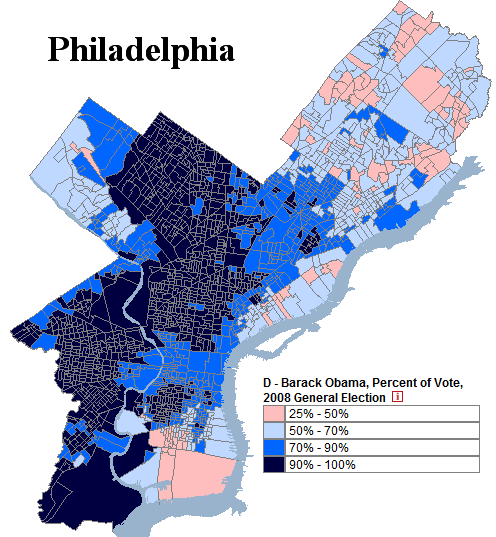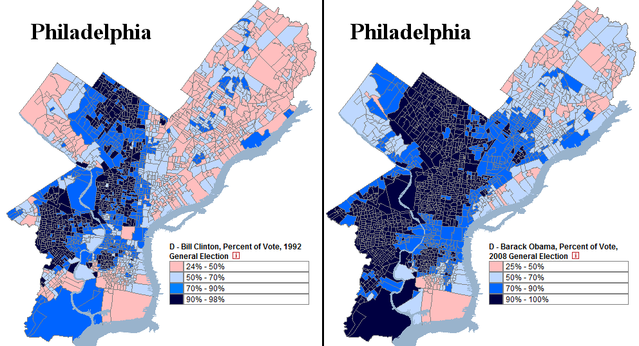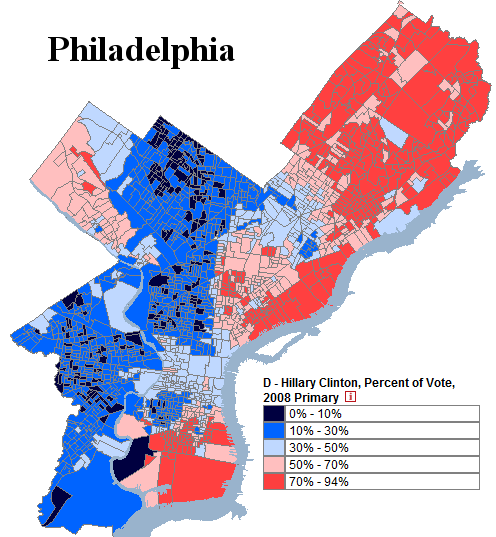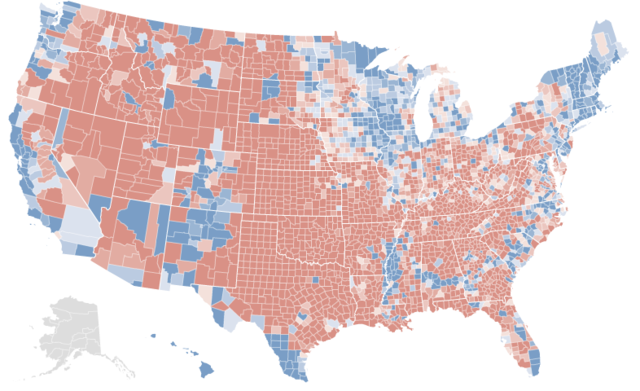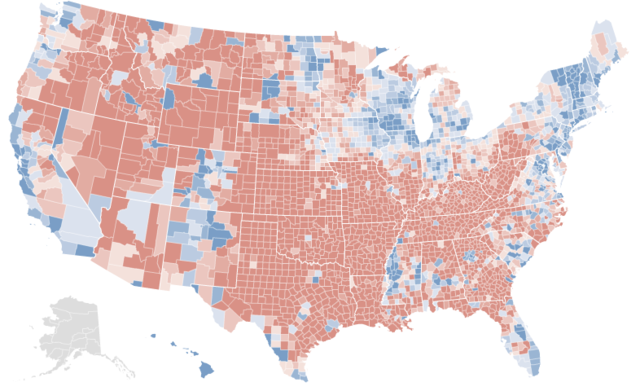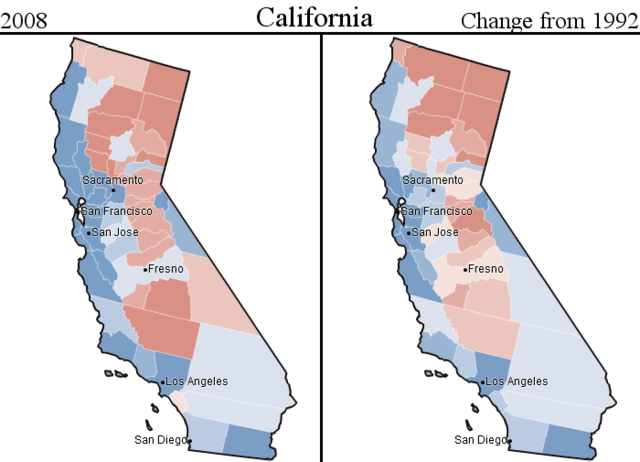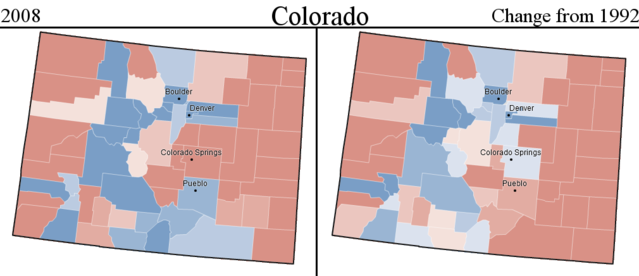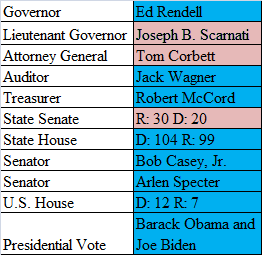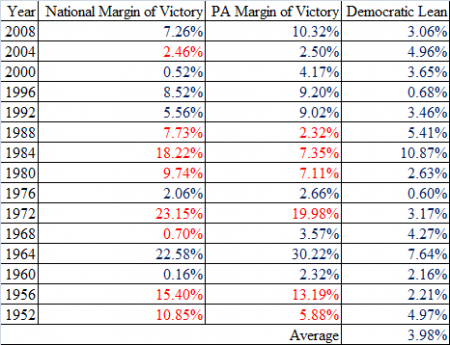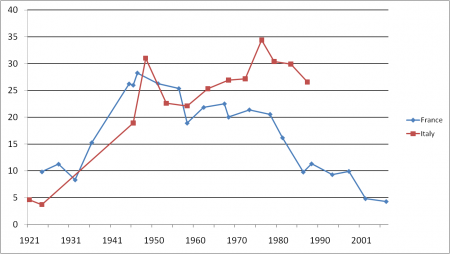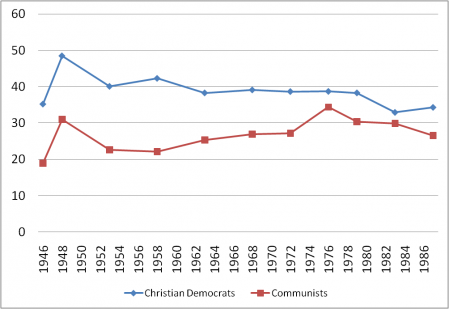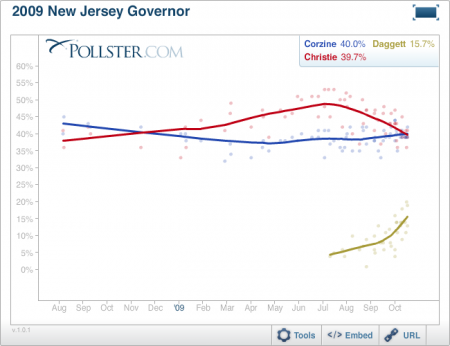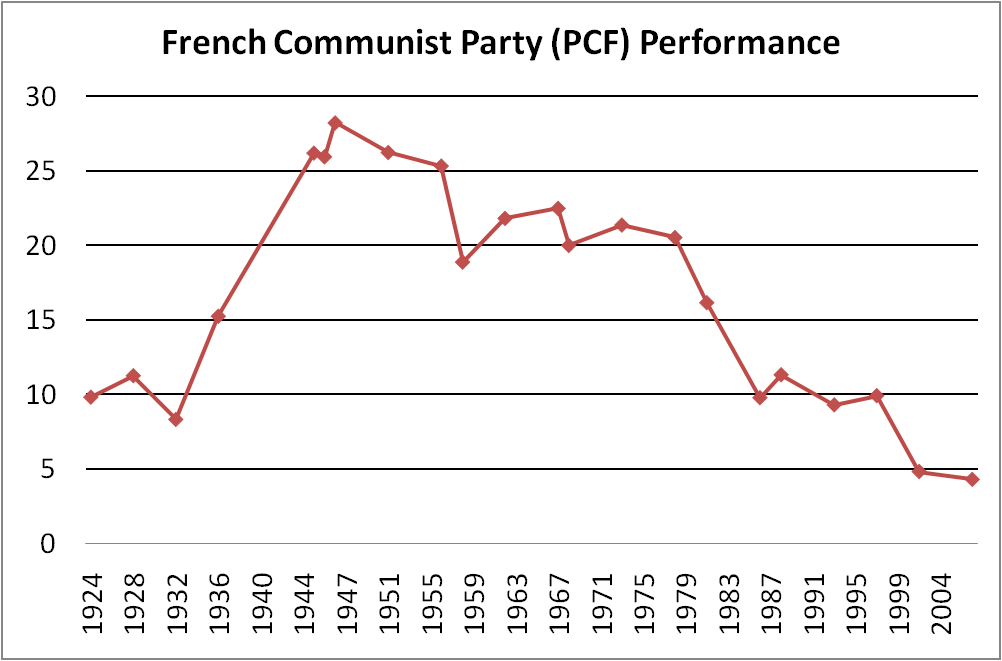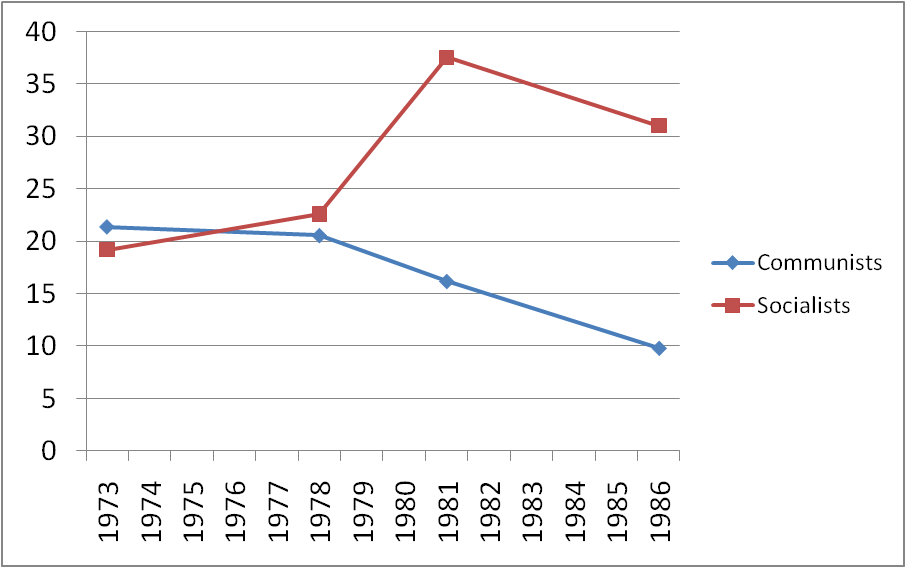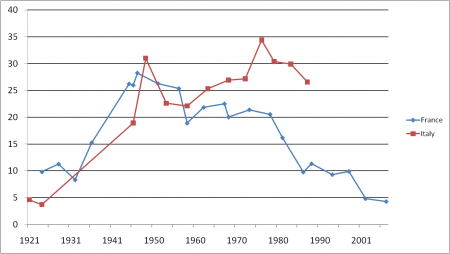Every fall I get election fever. And when it comes to odd-numbered fall like this one, nostalgia gets the best of me and I get to remembering the dramatic moments of elections past. I got to thinking today of how many great Senate races I’ve witnessed over the last 20 years, which entails the time period where I’ve paid attention to Senate races, and ultimately decided it would be fun to make a list of favorites. As usually happens with me, I originally intended to make a top-10 list but thought of so many great races that I had to extend the list to a top 20. The two primary factors I considered were the excitement level and corresponding twists and turns of the Senate campaign, and ultimately the closeness of the margin. In some of these races, the bad guys prevailed, which I usually docked some points for but didn’t rule them out entirely simply because an exciting Senate race is an exciting Senate race no matter who wins. My choices below the fold….
Before I get to the top-20, I have to cite four races for honorable mentions….
1998 New York (Chuck Schumer vs. Al D’Amato)–A very high-profile race between two street fighter candidates made for some memorably salty ads and campaign banter. It was expected to be close but Schumer pulled away in the end and won very decisively (11 points).
2000 Michigan (Debbie Stabenow vs. Spencer Abraham)–There were a number of great Senate battles in 2000 and one of the best was in Michigan where one-term GOP incumbent Spencer Abraham was narrowly edged out by Congresswoman Stabenow in large part because of Al Gore’s better-than-expected showing at the top of the ticket provided coattails. Even so, the race wasn’t declared for Stabenow officially until the wee hours of the night (as in after all the networks prematurely called the Presidency for Bush).
2006 Montana (Jon Tester vs. Conrad Burns)–Right up until that last two weeks of the race, I had thought Tester had an easy win coming given incumbent Conrad Burns’ multiple scandals, especially his alleged involvement with Jack Abramoff. When late polls showed Burns catching up, I didn’t believe them at first, but sure enough come election night it was razor thin as Tester hung on by a mere three thousand votes and wasn’t declared the winner until mid-morning Wednesday. For some reason, even in the darkest moments, I still sensed that Tester would prevail, however, but for the life of me I’ll never understand why a turd like Burns made it so close in that environment.
2002 Minnesota (*Paul Wellstone vs. Norm Coleman)–Here’s a contest I give an asterisk for because it was poised to be one of the best Senate races in memory. I lived in Minnesota at the time and the excitement surrounded this race was electric even during the summer, always testy but never plunging to the depths of sleaze that Coleman was capable of. This was the peak period of suburban shift to the GOP in Minnesota, so Wellstone was depending upon a very traditional “DFL” coalition of urban and outstate working class voters and farmers, who generally had a rising opinion of Wellstone given his advocacy for agriculture issues. When Wellstone began to pull away in mid-October at the very time Republicans were counting on him to implode due to the Iraq War vote, it was an amazing development. Of course we all know the tragedy that killed Wellstone and sucked all the oxygen out of the exciting race. Walter Mondale admirably filled in for Wellstone at the 11th hour, but the memorial service was such a PR trainwreck that I definitely sensed things had imploded in the final days of the campaign and that Coleman would win. One of the most exciting races I’ve ever seen ended in the most disastrous way, thus keeping it from my top-20 list by default.
Now, onto the top-20…..
#20. 2008 Oregon (Jeff Merkley vs. Gordon Smith)–Most late polls suggested two-term incumbent Gordon Smith was poised to lose his seat to Merkley, and I became pretty comfortable with the narrative that Smith was toast. I was thus surprised when the returns rolled in showing Smith ahead with ALL of the Portland vote in. I had written this race off until some point the next day when new information became available saying that most of the Portland vote was in fact not yet in and that the information saying it was was incorrect. It was one of those not-as-rare-as-you-think moments where the media gets it wrong and the amended figures give new life to one candidate presumed dead and punches the other candidate who thought he/she had a lead in the gut. Luckily, in this case, the Democrat Merkley got the good news.
#19. 1992 Georgia (Wyche Fowler vs. Paul Coverdell)–I don’t remember much about incumbent Democrat Wyche Fowler, only that he was considered too liberal for Georgia. So even when Georgia was giving a narrowly 43% plurality to Bill Clinton in the Presidential election of 1992, Fowler had similar difficulties in attaining a 50% plus one majority, which is of course required for official victory in Georgia. Fowler narrowly beat the conservative Republican Coverdell on the election night vote, but fell short of a majority. As a consequence, there was a runoff a few weeks later which gave a decided advantage to Coverdell. As expected, Coverdell won the runoff, but even that was closer than one may have guessed considering how soundly Saxby Chambliss crushed Jim Martin in a similar runoff this year. Coverdell won by about one percentage point and regrettably led the way for a much more Republican Georgia in the years ahead.
#18. 2004 South Dakota (Tom Daschle vs. John Thune)–I know, I know. The outcome was disastrous, but the magnitude of the grudge match was ferocious beyond anything I’ve ever seen and made for a yearlong bout of hand-to-hand combat that I got to experience first hand when I visited South Dakota a few times in the summer and fall of 2004. In that tiny corner of America, the epicness of that Senate race exceeded by leaps and bounds what was the most intense Presidential campaign I’ve ever witnessed. As someone who’s always been fascinated by the battle lines in South Dakota’s many jarlid-tight state elections, I knew exactly what to look for amidst the early returns to see how things were going on election night. I felt things slipping away in the final week of the campaign and was thus not surprised when those early returns were not where they needed to be to sustain a Daschle victory. I had a heavy heart by evening’s end when I saw that Daschle was keeping it close, but with 10% of the vote left it was clear he was not gonna win. Sad ending, but an exhilirating 12 months getting there.
#17. 2004 Florida (Betty Castor vs. Mel Martinez)–Another race with an unhappy ending but nonetheless a political scientist’s dream contest due to demographic anomalies of the contest. It was a masterstroke for Republicans to nominate Martinez to run for the open seat vacated by Democrat Bob Graham given that they needed to consolidate the increasingly less reliable Cuban vote around George Bush in the Presidential race and simultaneously inflate Republican margins in Hispanic-heavy central Florida near Orlando. It worked like a charm at both levels and Martinez carried Miami-Dade County and Orange County (Orlando), and likely giving Bush an assist with the same voters. On the other hand, Democrat Castor seemed to benefit from not being a person of color in northern Florida, winning rural counties near Tallahassee that usually lean Republican in state elections. Furthermore, Castor’s home base in the Tampa-St. Petersburg area boosted her margins there and almost offset Martinez’s advantage in Miami-Dade and Orlando. Martinez eked out a win of less than two points but it was a fascinating horse race until the wee hours of the night when it finally became clear Martinez was gonna win.
#16. 2000 Nebraska (Ben Nelson vs. Don Stenberg)–In one of the toughest states for a Democrat in what was arguably their toughest year in recent memory, the party had a herculean task of holding onto the Senate seat vacated by Bob Kerrey. Formerly popular conservative Democratic Governor Ben Nelson was their only hope, even though he managed to blow what was thought of as a sure thing in the 1996 Senate race against Chuck Hagel. And this time he had a better-known challenger in GOP Attorney General Stenberg. Fighting a ferocious partisan tide where Bush was beating Gore 2-1, Nelson’s race became very close in the end and holding it was a necessity for any hopes the Democrats had of retaking the Senate in 2000. Democrats swept all but one of the incredibly close races that drug on into the a.m. hours just like that year’s Presidential elections. It wasn’t until about 15 minutes after Bush was wrongly declared the winner in 2000 that the Nebraska Senate race was called for Nelson who prevailed by less than two points. Nelson’s definitely not my kind of Democrat, but it’s the only close statewide race in Nebraska I remember, and thus provides a helpful geographic baseline for where Democrats can be expected to win in future competitive Nebraska elections, assuming there is another one.
#15. 1998 Kentucky (Jim Bunning vs. Scotty Baesler)–Incumbent Democrat Wendell Ford was retiring in a state that was rapidly trending Republican in the late 1990s, leaving Lexington-based Democratic Congressman Scotty Baesler a tough Senate seat to hold. We all know Bunning as the cantankerous and senile Senator who sleeps through health care hearings, and the only thing different about him in 1998 was that he was only a Congressman from the uber-conservative southern suburbs of Cincinnati in northeastern Kentucky. The regional split was one of the primary contributors to the battleground Senate race’s ultimate tightness, with margins that stayed within a few thousand votes almost the entire evening and well into the a.m. hours. Unfortunately, it seemed like it was Bunning who was always narrowly ahead with each new set of returns that rolled in. And so it went as Bunning ultimately prevailed by about one-half of one percentage point. The upside from the race is that even though he’s on the blue team, it strikes me as doubtful that Baesler would be capable of as much unintentional comedy as Bunning has during his Senate tenure.
#14. 2008 Alaska (Mark Begich vs. Ted Stevens)–This was very close to
becoming the #1 most depressing Senate election of all-time as a corrupt incumbent less than two weeks removed from a felony conviction came within a hair’s breadth of retaining his Senate seat. Particularly after the selection of Sarah Palin as the Vice-Presidential nominee, I knew that unless he was convicted before the election, Stevens was likely to get another term. But following the conviction, I thought Begich’s victory was secured. How could this possibly be, I thought to myself when the final count the morning after the election showed that Alaska voters decided to go with the felon. Initially I held out little hope that Begich could come from behind, and I came across alot of online crowing by Republicans defending the felon in their ranks and his would-be defeat of Begich. But then I started hearing murmurs that the remaining votes appeared to be in Begich-friendly terrain. Alaska is the most annoying state in the country as far as determining where the vote count in any given race is coming from, so Begich’s comeback struck me as more of an article of faith than anything else. Nonetheless, he pulled it off in the end. Still, Begich’s microscopic marging of victory against a convicted felon with an (R) next to his name underscores how difficult this seat will be to hold in 2014.
#13. 1996 South Dakota (Tim Johnson vs. Larry Pressler)–Almost all of the battleground Senate races were going against us in 1996, including Maine, New Hampshire, Nebraska, Arkansas, and even Oregon. There were two bright spots, one of which was South Dakota, the state that has had by far the most close Senate elections in the last quarter century. In this case, three-term Republican incumbent Larry Pressler was facing a challenge from the state’s lone Congressman, Democrat Johnson. It struck me as a ballsy move for Johnson to give up his safe House seat to take on Pressler, particularly in Republican South Dakota and with Bill Clinton coming up 11,000 votes short of winning South Dakota even against Bob Dole. But he gauged Pressler’s vulnerability well and narrowly won in what was the most geographically divided race in a state that’s always geographically divided as the split between Pressler’s red counties and Johnson’s blue counties was almost perfectly divided between the west and east sides of the Missouri River.
#12. 1998 Wisconsin (Russ Feingold vs. Mark Neumann)–I was going to ollege in the northeast corner of Iowa in 1998, which is in the La Crosse, Wisconsin, media market. For that reason, I was personally invested in this reelection race, especially it was for one of my favorite Senators who had been made vulnerable for his own convictions. Riding a 20-point lead in the summer, Feingold wanted to stand by public financing quotas rather than take PAC money, but his Republican opponent Neumann, a Congressman from southeast Wisconsin, had no such trepidation from taking PAC money and ultimately saturated the airwaves with Feingold-bashing ads. That 20-point lead melted and by October the race was a tie. The Democratic Party was furious with Feingold for making himself vulnerable, especially since there were some indications the Republicans could gain enough seats for a filibuster-proof majority that year. Things didn’t work out at all as expected of course and the Democrats began winning almost every battleground Senate race, and winning them quite handily. After seeing all those victories accumulating, I found myself less fearful that Feingold would be taken out. Sure enough, only about an hour after the polls closed, they called the race for Feingold. Still, his winning margin was a mere two points, far closer than it should have been against a douchebag like Neumann.
#11. 2000 Washington (Maria Cantwell vs. Slade Gorton)–There were about five hotly contested Senate races still not called after midnight on election night 2000. If the Democrats ran the table on them, they could take over control of the U.S. Senate. Called fairly early was the Washington race, with Cantwell declared the winner far sooner than she should have been. In case nobody noticed, the networks had a bit of an issue with prematurely calling election contests in 2000. Washington does so much of their vote by mail-in ballots and whatever early advantage Cantwell had all but disappeared as the late votes began to be counted disproportionately for the GOP incumbent Gorton. She held on, but by a mere 2,000 votes out of nearly 2.5 million cast. In a year full of close Senate contests, this one was the closest….and it was days before Cantwell’s victory was made official.
#10. 2006 Tennessee (Harold Ford vs. Bob Corker)–I have a special fascination with the regional eccentricities of Tennessee politics, particularly in the post realignment era where Democratic victories have become increasingly difficult. With that in mind, the longshot 2006 Senate race featured such a herculean uphill fight for so many different reasons that I couldn’t look away. I don’t care for him that much personally, but Harold Ford is nonetheless a smart politician who seemed more capable than just about anyone else with a (D) next to his name of winning this seat, despite being an African-American in a Southern state and the controversies surrounding his family. Furthermore, there was a contentious GOP primary featuring three players with different strengths and weaknesses to bring to a contest with Ford. Even after Labor Day, when polls showed Ford ahead, I was extremely doubtful the blue team could win this one because I knew that, among other things, the Republicans would blow the race card dog whistle and manage to turn the contest into a racial pissing match. I left Ford dead in the final two weeks, but I’ll be damned if Ford didn’t fight his way back at the very end. The good news for Ford is that he held Gore’s 2000 coalition almost down to the county, pulling off wins in the rural Yellow Dog Democrat strongholds in the Tennessee River Valley in West Tennesse and the Cumberland Plateau in Middle Tennessee, as well as a margin about six points higher than Gore did in metropolitan Memphis. The bad news was it still wasn’t enough. The missing puzzle piece for both Gore and Ford was shoring up the majority of Lincoln Davis’ TN-04 district in the Jack Daniels country south of Nashville and east of the Cumberland Plateau, and area that has been trending very Republican this decade. Still, for a brief moment in time when those boffo numbers out of Memphis were rolling in, I thought Ford may be able to pull off what would have been an astounding and historical victory.
#9. 1996 Louisiana (Mary Landrieu vs. Woody Jenkins)–The media’s frame of this “historic” race was that Louisiana was about to have either its first woman Senator or its first Republican Senator. Landrieu struck me as a bit of a longshot in conservative Louisiana, but she could not have chosen a better year to run riding the coattails of Bill Clinton who won the state by what now seems like a mind-blowing 12 percentage points (yes Virginia, there was a time when Louisiana was winnable for a Democratic Presidential candidate). Even with that strength on the top of the ticket, Landrieu was locked in mortal combat well into the a.m. hours. Most battleground Senate races went to the bad guys in 1996, but Landrieu prevailed with a ridiculously small 50.1-49.9 margin, making it by far the closest Senate race of the 1996 cycle.
#8. 2006 Missouri (Claire McCaskill vs. Jim Talent)–I watched all of the Meet the Press debates featuring candidates from the battleground Senate races in 2006, and found the Missouri debate to be the best of the bunch. Both candidates seemed above-average in both style and ubstance. I had gone out on a limb predicting early on that McCaskill would upset Talent after some promising early poll numbers. It was a seesaw struggle the entire cycle and the conventional wisdom played out on election night with a two-point race. With the majority of the vote in, it looked as though Talent was comfortably ahead but most of the Kansas City and St. Louis vote was still hanging out there….but would it be enough? My sense is that it was, and I was right, but only by about 20,000 votes. The most surprising development of the race was that the stem cell initiative on the ballot that was supposed to provide coattails to McCaskill prevailed by even smaller margin than did McCaskill.
#7. 1998 Nevada (Harry Reid vs. John Ensign)–I never quite understood what Nevada, formerly a Republican stronghold, saw in the milquetoast Harry Reid, who is hardly a charismatic figure to make him the one acceptable Democrat they were willing to continually re-elect. But Republicans got aggressive in 1998 by nominating Ensign, the two-term Congressman from the least conservative part of the state (Las Vegas), to take Reid on. The race was below my radar screen for the longest time so I was actually quite surprised to see it become the closest race of the cycle, with Reid prevailing by a mere 400-some votes and not declared the winner until about 24 hours after the polls closed on election night. In retrospect it seems a little surprising Reid was able to beat Ensign in that situation. If Reid is lucky, he’ll score another 400-vote victory in 2010, which may make November 1998 seem like the good old days to him.
#6. 2000 Missouri (Jean Carnahan vs. John Ashcroft)–I suppose it’s a little ghoulish rating this race so high since the Democratic nominee on the ballot, Governor Mel Carnahan, died two weeks before the election in a plane crash, but the surreal nature of the aftermath is nonetheless about as compelling of a political narrative as I’ve ever come across with Carnahan’s widow poised to get appointed to the seat if Mel Carnahan posthumously won the election. The Missouri race was one of several 2000 Senate elections that was so close that it wasn’t called until well after midnight, and it didn’t become real for me until the race was officially called for Carnahan. And the outcome of the race took on special meaning when Ashcroft was appointed as Attorney General. For the next several years, Democrats got to rub Bush supporters’ noses in the fact that their own controversial Cabinet members couldn’t even hold onto a Senate seat when their opponent was a dead man.
#5. 2008 Minnesota (Al Franken vs. Norm Coleman vs. Dean Barkley)–In terms of tightness of margin and length of recount, this should perhaps be higher on the list, but for me the race lacked drama. At no point before the final month of the campaign did I buy the premise that the stoic Scandinavians who I grew up with would be able to take Al Franken seriously. But when Franken proved to be a serious candidate and Coleman, who had ran contentious but by and large civil campaigns in his previous two statewide elections, plunged to a level of campaign sliminess that drove Coleman’s own negatives down further than Franken’s. The gadfly Independence Party saw the opening and ran their best-known candidate in Dean Barkley, who seemed like a sane alternative for those who at that point disliked both Franken and Coleman. Once Barkley was scoring double digits in the polls, the race became not only unpredictable, but almost impossible for even a hard-core political aficianado to handicap. In the end, the race played out the way polls suggested, with Barkley scoring 14% and Coleman and Franken deadlocked for the rest. Strangely enough, for as uncharted of territory as this race originally appeared to be, the county map for the 2008 Senate race looked almost identical to the 2004 Presidential county map in Minnesota, with the only difference being Coleman scoring wider margins than did Bush in the second and third-ring suburbs. And of course enough has been said about the six-month recount that ultimately drug on far too long and ultimately stained the legacy of this race, at least for me.
#4. 2004 Kentucky (Dan Mongiardo vs. Jim Bunning)–Seriously, the 2010 Senate election is gonna be boring with Jim Bunning around. The 2004 race took on dimensions of weirdness of which I could have never imagined…and certainly wouldn’t have guessed would be rewarded with re-election. To be fair, Bunning’s comfortable Labor Day lead collapsed after the otherworldly detours (using teleprompters during debates; not attending public events out of fear that Osama bin Laden was after him; and accusations of “little green doctors pounding on his back”) started popping up almost every other day. Had the election been a week later, it’s likely that the surging Mongiardo would’ve prevailed but the clock ran out too early and Bush’s 20-point shellacking of Kerry at the top of the ballot proved too strong of a headwind to successfully wade through. Looking at the county map, one would have presumed Mongiardo had done enough to win. He scored impressive double-digit margins in Jefferson County (Louisville) and Fayette County (Lexington) and ran up the score big-time in the Democratic coal counties of east Kentucky, which is where Mongiardo’s legislative district was. He even won most of the conservative Democratic counties in western Kentucky which have been mostly out of reach for Democrats since the dawn of the Bush era. Bunning’s 51-49 margin came on the strength of his performance in northeastern Kentucky, where Bunning had been the House member before moving to the Senate. And not only did Bunning run up the score in the Cincinnati suburbs, he also overperformed typical Republican numbers in the more rural counties in and around Ashland in northeastern Kentucky. Had Mongiardo only managed to pull in the usual numbers that Democrats do
in those counties, he’d likely be running for a second term rather than a first term next year.
#3. 2006 Virginia (Jim Webb vs. George Allen)–Only a year before the 2006 Senate elections, George Allen was considered one of the most secure incumbents in America and at or near the top of the 2008 Presidential candidate short list. There was even talk in some circles of the Democrats recruiting actor Ben Affleck to run against him. Thankfully that went nowhere but it still seemed far out of reach for would-be Democratic challenger Harris Miller to take out Allen. Then, from out of nowhere, former Republican and Secretary of the Navy Jim Webb stepped up to the plate. At first he seemed a longshot even to win the primary but ultimately pulled it off, and it was after the primary win that I finally envisioned a scenario where Democrats could conceivably win this race. Still, Allen could probably have not spent one minute on the campaign trail and prevailed in this race due to his artificial popularity. Thankfully he did head out onto the campaign trail, making mistake after mistake after mistake, at one point sending campaign goons to slam a peaceful protestor into a plate-glass window a week before the election. Despite this comedy of errors, I was shocked that the race was as close as it was on election night. Having seen the baseline for a narrow Democratic win in Virginia only one year earlier by Tim Kaine, I wasn’t seeing comparable numbers roll in for Webb, especially in the Tidewater area. With about 80% of the vote in, I was starting to doubt Webb’s ability to win. He would have to win as big if not slightly bigger than Kaine had in northern Virginia to pull this thing out. But lo and behold, the numbers from Loudoun and Prince William Counties came in along with a few heavily black urban centers and Webb came from behind, albeit by the narrowest margin of the entire election cycle (50.1-49.9), and Webb was declared the winner the evening after the election. I’d be interested to see Webb’s approval ratings heading into his 2012 reelection race…just to see how vulnerable he would be.
#2. 2002 South Dakota (Tim Johnson vs. John Thune)–Here was a race where early polls suggested trouble for one-term incumbent Tim Johnson,
who now found himself in the same situation he had put Larry Pressler in six years earlier facing the state’s sole House member. But Johnson battled his way back by the fall of 2002, largely by default. South Dakota was suffering a severe drought in 2002 and Mr. Popularity (at the time) President Bush came to South Dakota to campaign on behalf of Thune….or at least in theory. Bush actually had the arrogance to tell a group of South Dakota ranchers they’d have to suck it up without any federal drought relief…and put Thune in the awkward position of agreeing with Bush. As a result, Johnson surged in the polls to either a tie or a small lead. Of course, almost every battleground Senate race went against us in 2002 and by the time I went to bed around 2 a.m., it looked as though the South Dakota race was going the wrong way as well (when I go to bed before dawn on an election night you KNOW things are going badly!). The Thune-friendly West River numbers were rolling in and Thune was starting to pull ahead. When I woke up in the morning, the first place I looked was South Dakota to see if Johnson pulled it out. Thune was 500 votes ahead with ONE PRECINCT left to report. I thought to myself that there was only one single precinct in the state of South Dakota capable of making up that much ground for Johnson and quickly checked on Shannon County, home of the Pine Ridge Indian Reservation, to see if that was indeed the precinct yet to report….and it was! It was the equivalent to a half-court hail mary shot at the buzzer, but when I checked South Dakota again a couple hours later, the final precinct reported and the margin had been reversed. Thune’s 500-vote lead had become Johnson’s 500-vote victory. It doesn’t get much more dramatic than that.
#1. 1990 Minnesota (Paul Wellstone vs. Rudy Boschwitz)–This race isn’t at the top of my list due to the breathtaking closeness of its margin, but rather the shock-the-world caliber of the upset and the fact that the winner of the race would become my favorite Senator in my lifetime. Early in 1990, slimy two-term Republican Rudy Boschwitz was rated as the safest incumbent in the nation. The Democrats had difficulty finding a credible challenger and ended up selecting a flamboyantly liberal activist and college professor named Paul Wellstone, who Democrats privately feared would be so weak that he would hurt other Democrats down the ticket. But sometime around Labor Day, something happened. Boschwitz was running “positive” ads just dripping with the arrogance of an out-of-touch incumbent (“when you see Rudy at the fair, he may only have a few moments to talk to you….because he’s the Senator for ALL of Minnesota”)Meanwhile, the penniless Wellstone campaign was starting to generate some buzz with its colorful candidate and his humorous and offbeat TV ads. Boschwitz was caught flat-footed and reacted with a panic, making a megagaffe a week before the election when it sent out a letter to Jewish supporters citing Wellstone as an “improper Jew” because he married a Christian woman. Meanwhile, the energy surrounding Wellstone was explosive and contagious. I was in seventh grade and barely tuned in, so it wasn’t until the final couple of days of the campaign that I began to
seriously entertain the idea that Wellstone could win. But win he did, prevailing by three points in the a.m. hours. Even if Dan Mongiardo had prevailed against Bunning in 2004, it wouldn’t have been as mind-blowing of an upset as what Wellstone accomplished in 1990. I’d be incredibly surprised if an upset of this magnitude is ever seen again in a U.S. Senate race.
So there’s my top-20 list. I hope people have enjoyed the list and welcome any additions others may have, either from the last 20 years or some golden oldies of decades past.
